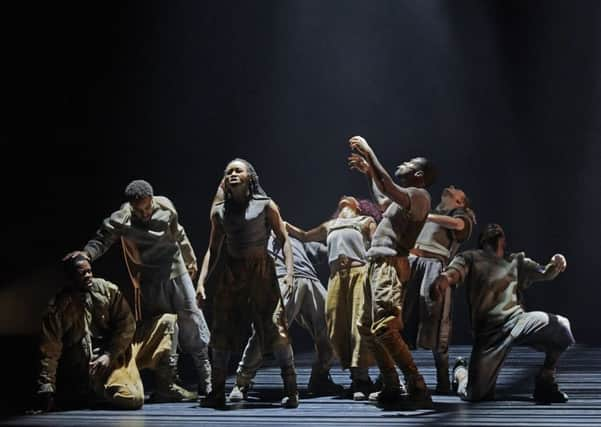Festival show taking hip hop to a whole new level


Asante, who came up with the original idea for the show and composed the score, describes how he created a “museum” for the rest of the team to “walk through”. Pulling together thoughts and emotions about his African heritage, reflections on modern-day Britain, photographs and research, he put them all on a mood board in the rehearsal room. Choreographer Sandy then “filled a bath,” as he puts it, with everything Asante brought in, and “immersed myself in it”.
The resulting triple bill was nominated for an Olivier Award and Boy Blue will soon become the first hip hop dance company to play the Edinburgh International Festival. Much of which is down to the hugely successful partnership between Asante and Sandy, which began officially in 2001 when they formed their company in east London – but actually dates back much further.
Advertisement
Hide AdAdvertisement
Hide Ad“First and foremost, me and Michael are like brothers,” says Sandy. “We’ve known each other since we were 12, so he’s grown with me in the same way that I’ve grown with him. But I think one of the major things that makes the partnership successful, is we put our egos aside and look at the bigger picture.
“We’re both strong-minded people, both quite stubborn and very fixed on what we feel is right. But we also know when to fight about something to get a point across, and when to put that to one side and listen to what the other person is saying, because that in turn could inspire you.”
The other key ingredient, instrumental in Blak Whyte Gray’s popularity with both audiences and critics, is the dancers. Watching them move, the speed and precision of their synchronised movement is mesmerising. How does Sandy bring that quality out of them?
“It’s drilling – both physically and psychologically,” he explains. “I say to them, when you do a move, what is the aim and objective behind it? It’s just like a script – when you deliver a line, what are you saying with it? So if you put that same preciseness into a move, you have to know what you’re saying with that piece of movement, what you’re articulating.
“One of the major things I say in rehearsals is projection, articulation, pronunciation. If you’re just throwing your arms, you’re throwing your conversation – I don’t know what you’re saying. If you’re delivering your moves too quickly, you’re speeding up your conversation. A conversation needs to be clear and precise – project it, let me hear everything you’re saying.”
Sandy himself is an incredible dancer, so when he choreographed Blak Whyte Gray, he didn’t just shout directions from the sidelines – he was up there showing the dancers how it’s done.
“I’m very hands-on,” he says. “If I’m asking something of the dancers, I expect that I have to be able to do it myself, so they can see it and feel what I’m doing. And I’ll explain to them the reason why I’ve created a particular bit of choreography, the stimulus for the movement, so they can immerse themselves in the idea.”
Advertisement
Hide AdAdvertisement
Hide AdPrevious works by the company, including their Olivier Award-winning Pied Piper, stemmed from both Asante and Sandy. But this time around, it was Asante alone who was the driving force. Once he had shared his vision, however, Sandy was keen for the dancers to buy into it as much as possible.
“Mikey wrote a spoken word piece which we put on the mood board along with pictures and references,” explains Sandy. “And then we said to people, if you find a picture that you feel represents what we’re saying here, bring it in. That way, they started taking ownership of the piece, so they could give it more.
“Because whenever you’re working on someone else’s vision, and it’s not your baby, it’s about trying to make the dancers the godparents of that child so they also feel obligated to be responsible for that vision.”
With shows like Pied Piper and Blak Whyte Gray (spelt incorrectly so it’s closer to surnames than colours), Boy Blue is at the vanguard of hip hop dance theatre. Along with organisations like Breakin’ Convention, they’re proving that an auditorium and stage is now the rightful home of a genre which began on street corners and in warehouses, but has grown wings and flown in new and exciting directions.
No longer just about flips and tricks (though that remains an exciting aspect of it), hip hop dance generates atmospheric, emotionally rich works of real integrity – and Sandy for one would like to see more hands reaching out to push it forward.
“What Blak Whyte Gray has shown, is that hip hop is not just about putting a piece of cardboard down and freestyling on the streets,” says Sandy.
“Hip hop is a culture, it’s an expression – and that expression is coming to the Edinburgh International Festival and people are going to feel it. Hip hop has been around for so long now, it’s coming up for 40 years, so I think this kind of show is a good look for the Festival. And for us it’s definitely an honour to be put on that platform – I just feel there needs to be more.
Advertisement
Hide AdAdvertisement
Hide Ad“There are loads of shows out there, by us and other hip hop dance companies, and they’re not just dancing to mainstream music – it’s deep, honest, epic work. So now is the time for people to really start to look at hip hop dance theatre and support it.”
• Blak Whyte Gray, Lyceum Theatre, Wednesday 16 to Saturday 19 August, 7:30pm (Saturday matinee 2:30pm)